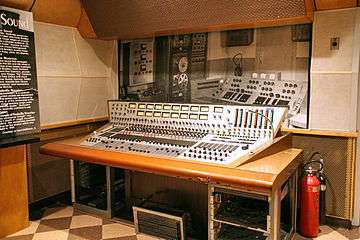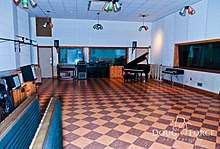RCA Studio B
RCA Studio B is a music recording studio in Nashville, Tennessee built in 1956. Originally known simply by the name "RCA Studios", it became known in the 1960s for being an essential factor to the development of the production style and technique known as the Nashville Sound.
| RCA Studio B | |
|---|---|
 | |

| |
| Alternative names | RCA Victor Studios Victor Sound Home of a Thousand Hits |
| General information | |
| Address | 1611 Roy Acuff Pl. |
| Town or city | Nashville, Tennessee |
| Coordinates | 36.1500°N 86.7928°W |
| Website | |
| https://studiob.org | |
A sophisticated style characterized by background vocals and strings, the Nashville Sound both revived the popularity of country music and helped establish Nashville’s reputation as an international recording center. Its adjacent building, RCA Studio A, was also later central to the development of this technical artistic sound.[1]

The studio is located centrally in the historic Music Row district. Currently studio B is managed by the Country Music Hall of Fame and it runs scheduled tours of the facility.
Beyond the countless recordings made by legendary music artists here, Elvis Presley is known to have made more than two hundred song recordings at this location.[2]
The National Park Service subsequently listed it on the National Register of Historic Places in 2012.[3]
Studio
Origins
In 1957, RCA moved from its first permanent Nashville recording studio at 1525 McGavock Street.[4][5][6] The new studio—built by Dan Maddox in 1956—was constructed at the request of Chet Atkins and Steve Sholes to facilitate the needs of RCA Victor Records and other record labels. According to Atkins,[7] the plans for the studio were drawn upon a napkin by Bill Miltenburg, RCA's chief engineer and recording manager.
Construction took four months, and the studio was opened at the cost of US$37,515 (Equivalent to US$345,087 as of 2018). The studio is a single-story building with offices occupying the front but the area of the studio and control room has a second story that contains an echo chamber. The studio itself measures 42.5 by 27 by 13 feet (13.0 by 8.2 by 4.0 m). In 1960 and 1961, an addition was built to provide office space and rooms for tape mastering and a lacquer mastering lab. A larger studio was built adjacent on 17th Avenue in 1964 and became known as RCA Studio A; the existing studio was referred to as Studio B from that point onward.
Improvements
The first chief engineer was Bob Ferris, a man who managed to make Atkins irritated enough that he had him assigned elsewhere. Bill Porter replaced him at the end of March 1959, and by June had mixed a number one hit: "The Three Bells" by The Browns. Porter considered the studio's acoustics problematic, with resonant room modes creating an uneven frequency response. To lessen the problem, he took some $60 from the studio's petty cash and bought fiberglass acoustic ceiling panels which he cut into triangles and hung from the ceiling at varying heights; these were dubbed "Porter Pyramids".[8] Porter also marked "X"es on the floor where he discovered, by careful experimentation, the resonant modes to be minimal. Porter positioned lead vocalists, background vocalists, and acoustic guitarists at microphones placed directly over his marks. After these improvements, Don Gibson recorded his album Girls, Guitars and Gibson in the studio. Porter later told an interviewer: "Everybody said, 'God, what a different sound!'"[9]
Events
Nashville painter and singer/songwriter Gil Veda—introduced to the Grand Ole Opry crowd as "The Spanish Hank Williams" in 1962—was the first Hispanic singer to record at RCA’s Studio B.[10]
In her 1994 memoir, My Life And Other Unfinished Business, Dolly Parton recounted how she was rushing to her first recording session at Studio B in October 1967 (shortly after having signed with RCA Victor) and, in her haste to make the session on time, drove her car through the side wall of the building. She noted that the spot where her car impacted the building is still visible.[11][12]
Learning facility
In 1977, the studio was made available to the Country Music Hall of Fame for tours, and in 1992 it was donated to the Country Music Hall of Fame by the late Dan Maddox. Until 2001, it was operated as an attraction when the new home for the Hall of Fame was built in downtown Nashville. The studio was co-operated by the Country Music Hall of Fame and Belmont University's Mike Curb College of Entertainment and Music Business program until 2012 when operation shifted solely to the Hall of Fame.[13] Students use the facilities for classes learning the basic techniques of analog recording. Daily scheduled tours of the studio are offered by the Country Music Hall of Fame and Museum.
List of notable artists recorded
Following is a list of some notable artists who recorded songs at Studio B.
- Eddy Arnold[14]
- Chet Atkins[14][15]
- Bobby Bare[14]
- Harold Bradley[15]
- The Browns[14]
- Jerry Byrd[14]
- Floyd Cramer[14]
- Skeeter Davis[14]
- Dottsy[14]
- Ronnie Dove
- The Everly Brothers[14]
- Donna Fargo[14]
- Connie Francis[16]
- Hank Garland[15]
- Don Gibson[14]
- Mickey Gilley[14]
- Bobby Goldsboro[14]
- Billy Grammer[14]
- Buddy Harman[15]
- John Hartford[14]
- Al Hirt[16]
- Homer and Jethro[14]
- Norma Jean[14]
- Waylon Jennings[14]
- Jack Jersey
- Grandpa Jones[14]
- The Jordanaires[17]
- Anita Kerr Singers[15]
- Hank Locklin[14]
- John D. Loudermilk[17]
- Bob Luman[16]
- Charlie McCoy[15]
- Roger Miller[14]
- Bob Moore[16]
- Willie Nelson[14]
- Notre Dame High School (Elmira, New York) [14]
- Roy Orbison[14]
- Dolly Parton[14]
- Elvis Presley[14]
- Charley Pride[14]
- Boots Randolph[14]
- Jim Reeves[14]
- Tommy Roe[16]
- Ronny & the Daytonas[16]
- Samuelsons
- Connie Smith[14]
- Hank Snow[14]
- Gary Stewart[14]
- The Strokes[14]
- Nat Stuckey[14]
- Sue Thompson[16]
- Johnny Tillotson[14]
- Ernest Tubb[17]
- The Velvets[14]
- Porter Wagoner[14]
- Gillian Welch[14]
- Dottie West[14]
References
- This article is mainly derived from the Country Music Hall of Fame web page: "About RCA Studio B" Archived 2010-02-26 at the Wayback Machine
- "Studio B Celebrates 60th". StudioB.org. Retrieved 2018-04-08.
- "Weekly List of Actions Taken on Properties: 7/09/12 through 7/13/12". National Park Service. July 20, 2012. Retrieved July 20, 2012.
- "'Heartbreak' Studio Demolished for Parking Lost". NPR.org. Retrieved 2019-07-18.
- "Scotty Moore – RCA Victor – 1525 McGavock St". scottymoore.net. Retrieved 2019-07-18.
- Staff 1/19/2006, CMT com. "Historic Studio Site Being Demolished in Nashville". CMT News. Retrieved 2019-07-18.
- Chet Atkins' autobiography
- Fremer, Michael (May 1, 2009). "Mr. Natural: Recording Engineer Bill Porter Part I". MusicAngle.com. Retrieved July 8, 2010.
- Rumble, John W. (1996). "Behind the Board with Bill Porter: Part One". The Journal of Country Music. 18 (1): 33.
- "Music and art mesh in Veda's storied life". www.tnledger.com. Retrieved 2019-07-18.
- Dolly Parton (1994). Dolly: My Life And Other Unfinished Business. Harper Collins. ISBN 0-06-017720-9
- "HowStuffWorks "Suggested Itineraries for Visiting Nashville"". September 27, 2008. Archived from the original on September 27, 2008.
- Belmont University, Belmont University Recording Studio Facilities Archived 2006-08-20 at the Wayback Machine
- "The Artists". Historic RCA Studio B. Nashville, Tennessee: Country Music Hall of Fame. Archived from the original on September 9, 2010. Retrieved August 8, 2010.
- McClellan, John; Bratic, Deyan (2004). Chet Atkins in Three Dimensions. 2. Mel Bay Publications. pp. 149–152. ISBN 0-7866-5877-0.
- Blakely, Larry (August–September 1982). "Bill Porter: Engineering Elvis" (PDF). Mix. 6 (8–9). Archived from the original (PDF) on June 29, 2011. Retrieved August 3, 2010.
- "Artists Recorded at RCA Studio B". Mike Curb Family Foundation. Retrieved August 8, 2010.